Featured Image: SpaceX
Lift Off Time | May 25, 2022 – 18:35 UTC | 14:35 EDT |
|---|---|
Mission Name | Transporter 5, the fifth SpaceX dedicated small satellite rideshare mission |
Launch Provider | SpaceX |
Customer | Numerous |
Rocket | Falcon 9 Block 5, booster B1061-8 |
Launch Location | Space Launch Complex 40 (SLC-40), Cape Canaveral Space Force Station, Florida, USA |
Payload mass | Unknown |
Where are the satellites going? | Sun-synchronous orbit |
Will they be attempting to recover the first stage? | Yes |
Where will the first stage land? | Landing Zone 1 |
Will they be attempting to recover the fairings? | Yes |
Are these fairings new? | No |
How’s the weather looking? | The weather is currently 80% go for launch (as of May 22, 2022 at 14:00 UTC) |
This will be the: | – 59th orbital launch attempt of 2022 – 165th mission for SpaceX all-time – 156th Falcon 9 flight – 54 day booster turn around time – 99th re-flight of a booster – 20th re-flight of a booster in 2022 – 122nd booster landing – 48th consecutive booster landing (a record) – 22nd launch for SpaceX in 2022 – 87th SpaceX launch from SLC-40 |
Where to watch | Official livestream |
What’s All This Mean?
SpaceX will launch their fifth dedicated small satellite rideshare mission, Transporter 5, from Space Launch Complex 40 (SLC-40), Cape Canaveral Space Force Station, in Florida. Onboard Transporter-5 are 59 payloads from several customers. Some customers have flown on previous Transporter missions, such as Satellogic on Transporter 4. The Falcon 9 Block 5 booster, B1061-8 will perform a boostback burn and touchdown on Landing Zone 1 (LZ-1).
What’s On Transporter 5?
A total of 59 payloads will be packed into the 5.2 m Falcon 9 fairing and deployed across nearly 20 minutes of mission time after reaching a Sun-Synchronous Orbit (SSO). The deployment sequence is determined by many variables including customer needs and satellite placement on the payload adaptor rings.
Payloads have specific volumetric constraints and interface with one of two rings, one with a 15 in diameter and the other a 24 in diameter. The larger ring allows for more volume, or a larger payload. Customers can also purchase the top slot, which allows for the largest possible payload on the mission. The 15-inch ring ports can support a payload mass up to 454 kg (1,000 lb) while the 24-inch ring ports can support up to a 830 kg (1,830 lb) payload mass.

Payloads included projects from Momentous, Satellogic, Nanoracks, Exolaunch, D-Orbit, and others
Outpost Demonstration Mission 1 (Nanoracks)
Nanoracks, which aims to provide affordable commercial access to space, in conjunction with Voyager will be launching the Outpost Mars Demonstration 1 (OMD-1). The demo aims to test and gather data on metal cutting in space and the reuse of abandoned space vehicles. Due to the difficulty of simulating microgravity in conjunction with a vacuum here on Earth, some experiments must be conducted in space.
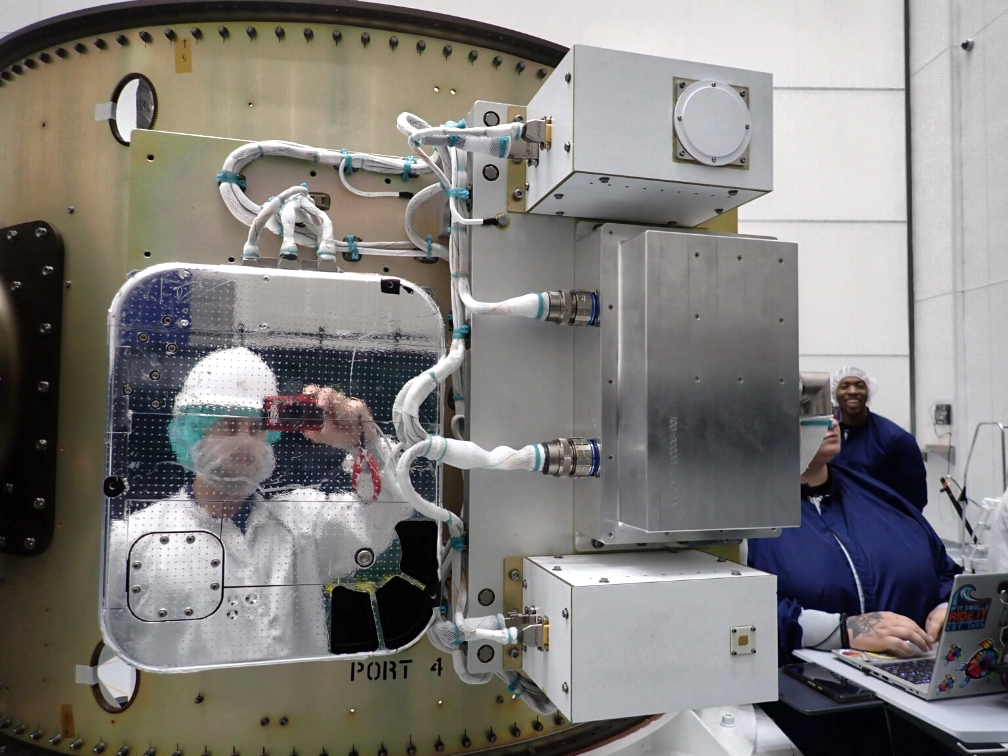
A video camera will be mounted to a robotic arm, developed by Maxar Technologies, with a cutting wheel, which when commanded, will cut through three coupons of CRES 316 stainless steel. This stainless steel is the same material used on the United Launch Alliance Vulcan Centaur. The experiment is only set to last a maximum of one orbit before losing battery power. The cutting will be activated about eight to nine minutes after launch, shortly after Second Engine Cutoff.
About 10 minutes later, once the experiment is complete, the team will downlink photo and video data to analyze the results of each of the three coupons. The resulting cuts are expected to be similar to each other, but there could still be differences. Previous cutting related experiments have been performed, specifically in the Apollo program, but none this sophisticated and with this method.
One of the biggest goals for OMD-1 is to cut metal without excess debris. Friction milling is the answer. Similar to friction stir welding, a technique used on many United Launch Alliance rockets, the cutting wheel heats up the metal to extreme temperatures. By doing so, the excess metal melts contrary to erupting from the material as macroscopic metal shards.
Three weeks prior to launch, the team mounted the payload onto the Falcon 9 upper stage. In an interview with Everyday Astronaut, Robbie Harris, Director of Advanced Concepts stated, “This is a unique mission for our company. We haven’t really done anything like this.” The mission will serve as a critical component to advancing Voyager and Nanoracks’ goal of converting upper stages into in-orbit outposts.
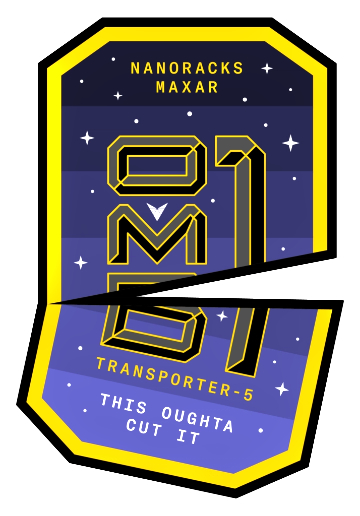
SELFIESAT
SelfieSat-1 is the first operational student satellite from Norway, built entirely in-house from off the shelf parts. Its bus contains a Raspberry Pi which serves as the payload computer for the satellite. The 1.8 kg satellite will, once deployed, extend a “selfie stick” which has a Raspberry Pi camera mounted on the end. Pointed back at the satellite, which has an LCD screen mounted on it, the camera will image the screen, satellite, and Earth.

Prior to launch, students in schools from around Norway submitted various images of themselves, pets, and friends to be stored on the satellite prior to launch. About one week after launch when teams in Norway have made contact with the satellite, the LCD screen will begin to display the stored images, take pictures of them, and beam the results back to Earth. Operations will be conducted from Trondheim, Norway with the team’s own ground station and radio tower.
One of the most critical components is the LCD screen. No LCD screen has ever been put in such harsh conditions; in a vacuum, in microgravity, and unfiltered sunlight. The SelfieSat team has spoken with NASA about the potential outcomes for the LCD screen, which will help NASA perfect the technology ahead of the Artemis program. This program could feature spacesuits or other instruments with externally mounted LCD screens.
Eventually, anyone from Norway and around the world will be able to upload their own images and, in return, received a picture of their image in space. SelfieSat will be able to survive 12 years in its 535 km Sun-synchronous orbit before reentering Earth’s atmosphere, but electrical components will fail before then. However, the public will enjoy the idea of bringing space down to Earth for as long as possible.
“We really wanted to inspire a new generation of space engineers in Norway because Norway doesn’t have many space opportunities like the United States,” said Orbit NTNU CEO Ulrik Falk-Petersen in an interview with Everyday Astronaut.

BRONCOSAT-1
Under the satellite service provider Momentous, BRONCOSAT-1 is a university designed satellite testing a new flight computer. Cal Poly Pomona (United States) constructed the 1.5U CubeSat which will host an NVIDIA Jetson nano GPU as it’s main flight computer. These smaller and cheaper flight computers will enable easier and cost affordable construction of satellites.
Capella 9
Shifting the focus to Earth, Capella 9, in conjunction with other Capella satellites, will be placed in orbit as part of an Earth observation system. Thirty satellites will eventually make up the constellation. Each satellite uses Synthetic Aperture Radar (SAR) imaging in the X band (8-12 GHz (gigahertz)). This band mainly provides data for urban areas and ice/snow monitoring as well as observations of vegetative decay. The X band does not penetrate vegetation easily and therefore can observe when vegetation is decreasing.
D-Orbit ION-SVC-006
The Como, Italy based company D-Orbit is launching their sixth satellite carrier vehicle on Transporter 5. D-Orbit has flown satellites on previous missions including Transporter 4. The ION Satellite Carrier weighs in at about 100 kg (220 lb) which deploys CubeSats from spring loaded dispenser pockets. The carrier can hold combinations of 1U, 2U, 3U, 3U+, 6U, 6U+, 12U, and 12U+ Cubesats as well as bolted payloads.
Other payloads
Numerous other payloads are also flying on Transporter 5 and serve a wide variety of services. These payloads include but are not limited to Vigoride VR-3, FOSSASAT-2E, Veery FS-1, Shared Sat 3, Planetum-1, Foresail-1, Spaceflight Sherpa-AC1, XONA Alpha, TROOP-3, GHGSat-C3,-C4,-C5, GHOSt-01,-02, STAR VIBE, KUbeSat, VariSat-1, PTD-3/Tyvak-0125, ICEYE US, Centauri 5, and CPOD A/B.
What Is Falcon 9 Block 5?
The Falcon 9 Block 5 is SpaceX’s partially reusable two-stage medium-lift launch vehicle. Block 5 is the final iteration of the Falcon 9; the goal is to apply all the lessons learned from 56 previous Falcon 9 pre-Block 5 flights into a human-rated reusable rocket. The Falcon 9 contains three main components: a reusable first stage, an expendable second stage, and a reusable fairing.
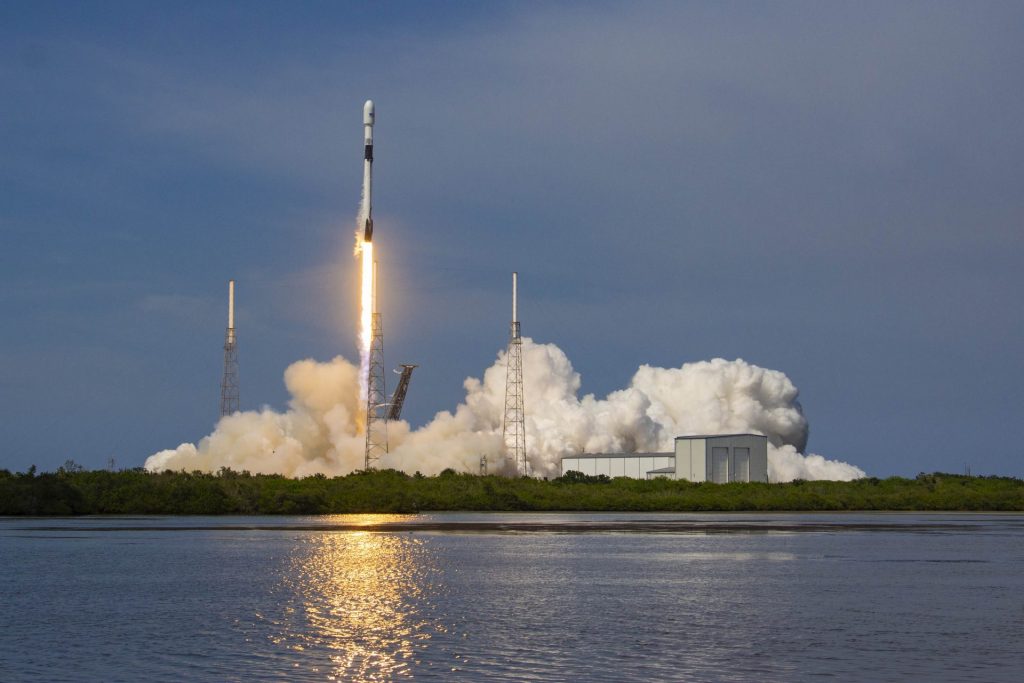
Block 5 updates:
SpaceX introduced a lot of changes on Block 5, allowing it to become the crew-launching reusable rocket that we know today. To start, the Composite Overwrapped Pressure Vessels (COPVs) had to undergo a complete redesign. NASA mandated the COPV redesign, as it had been the cause of both of the Falcon 9 failures: AMOS-6 and CRS-7.
Along with certification for human spaceflight, Block 5 came with a number of other major changes. To increase the amount of flight each booster could handle, and decrease the turnaround time, SpaceX reinforced the landing legs, upgraded the grid fins, and added a carbon fiber interstage. They also added heat-resistant external paint and upgraded the engines. For more information about the changes in Block 5, and the other Blocks of the Falcon 9, click the image to check out this video by the Everyday Astronaut:
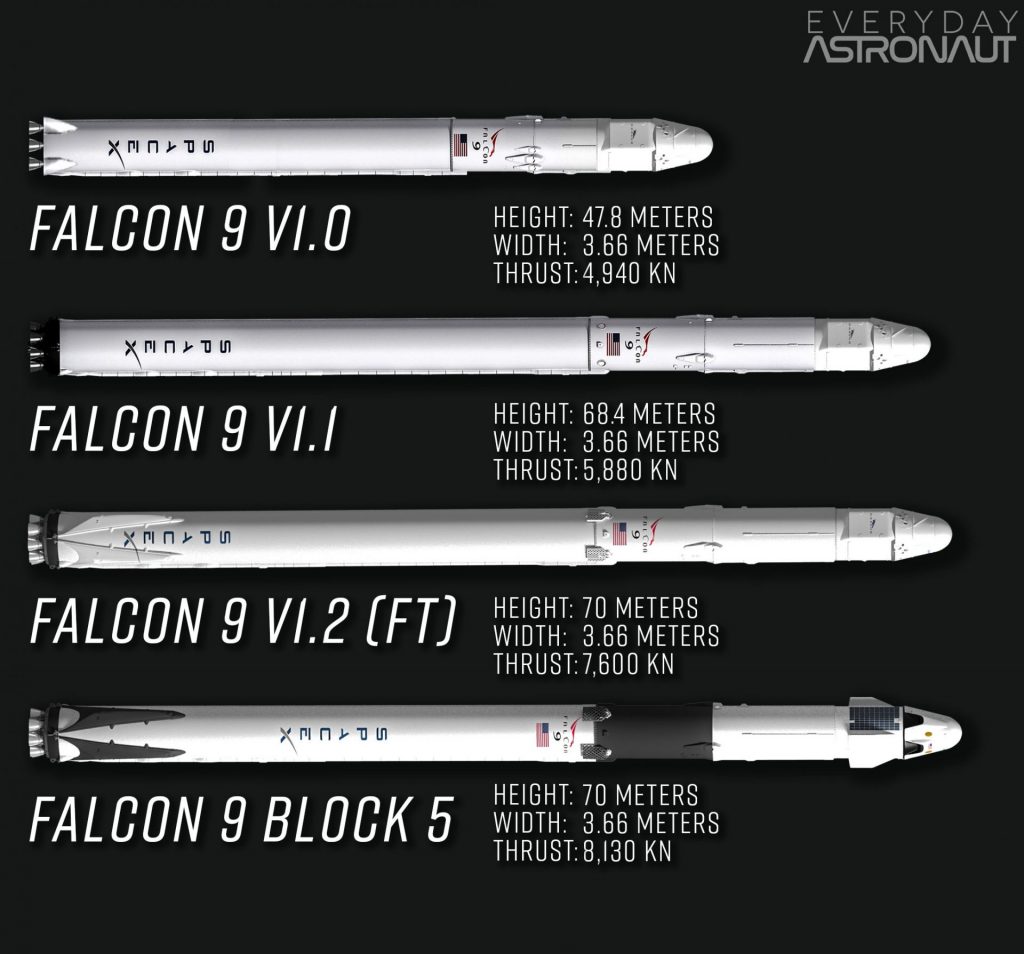
Falcon 9 Booster B1061
The booster supporting this mission is B1061. The booster has previously flown seven times. Transporter 5 will make its designation B1061-8.
| B1061’s missions | Launch Date (UTC) | Turn Around Time (Days) |
| Crew-1 | November 16, 2020 00:27 | N/A |
| Crew-2 | April 23, 2021 09:49 | 158.39 |
| Sirius SXM-8 | June 6, 2021 04:26 | 43.78 |
| CRS-23 | August 29, 2021 07:14 | 84.12 |
| IXPE | December 9, 2021 06:00 | 101.95 |
| Starlink Group 4-7 | February 3, 2022 18:13 | 56.51 |
| Transporter 4 | April 1, 2022 16:24 | 56.92 |
Following stage separation, the Falcon 9 will conduct three burns. It will first perform a boostback burn to Return to Launch Site (RTLS) followed by the usual entry and landing burns. These burns will softly touch down the booster on Landing Zone 1 (LZ-1).
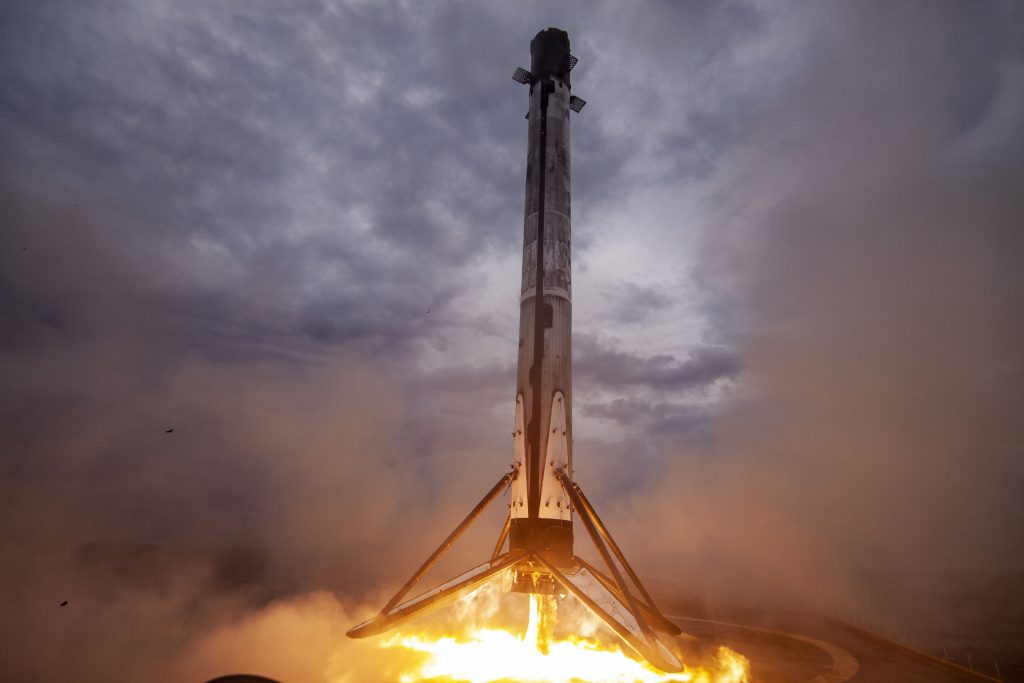
Fairing Reuse
SpaceX is the first launch operator that recovers and reuses its fairings. The recovery vessels, Go Ms. Tree and Go Ms. Chief, attempt to recover the fairing halves from the water. After being jettisoned, the two fairing halves use cold gas thrusters to orientate themselves as they descend through the atmosphere. Once at a lower altitude, they deploy parafoils to help them glide down to a soft landing for recovery.
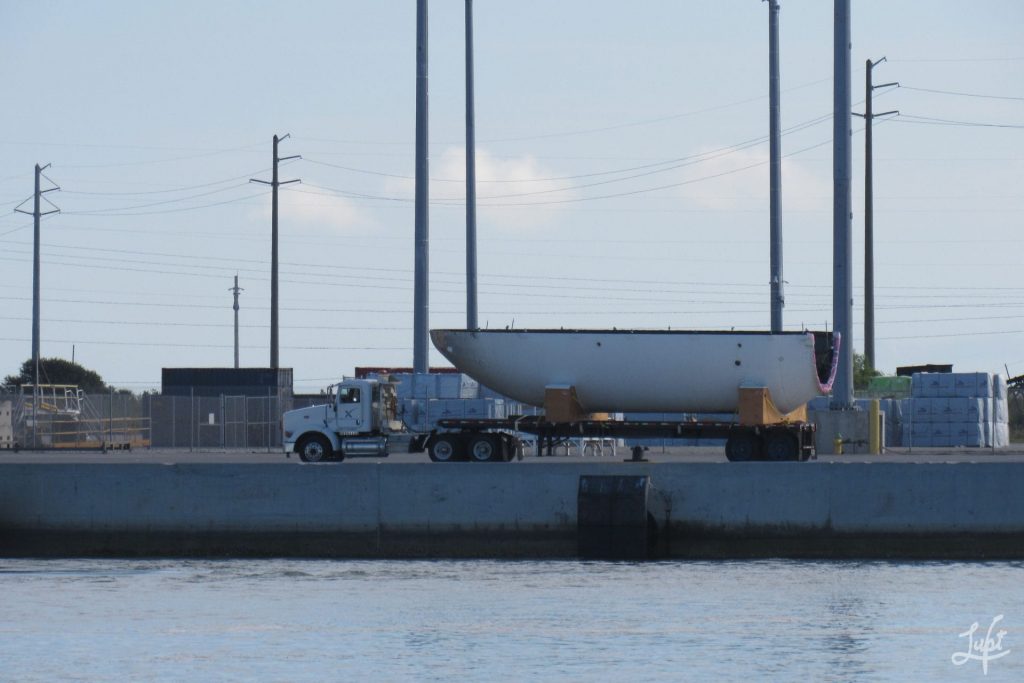
Transporter 5 Full Mission Profile
Hr/Min/Sec Event
| 00:38:00 | SpaceX Launch Director verifies go for propellant load |
| 00:35:00 | RP-1 (rocket grade kerosene) loading begins |
| 00:35:00 | 1st stage LOX (liquid oxygen) loading begins |
| 00:16:00 | 2nd stage LOX loading begins |
| 00:07:00 | Falcon 9 begins engine chill prior to launch |
| 00:01:00 | Command flight computer to begin final prelaunch checks |
| 00:01:00 | Propellant tank pressurization to flight pressure begins |
| 00:00:45 | SpaceX Launch Director verifies go for launch |
| 00:00:03 | Engine controller commands engine ignition sequence to start |
| 00:00:00 | Falcon 9 liftoff |
Launch, Landing, And Satellite Deployment*
Hr/Min/Sec Event
| 00:01:12 | Max Q (moment of peak mechanical stress on the rocket) |
| 00:02:16 | 1st stage main engine cutoff (MECO) |
| 00:02:19 | 1st and 2nd stages separate |
| 00:02:27 | 2nd stage engine starts |
| 00:02:32 | 1st stage boostback burn begins |
| 00:03:19 | 1st stage boostback burn complete |
| 00:03:47 | Fairing deployment |
| 00:06:43 | 1st stage entry burn begins |
| 00:07:08 | 1st stage entry burn ends |
| 00:08:00 | 1st stage landing burn begins |
| 00:08:25 | 2nd stage engine cutoff (SECO) |
| 00:08:33 | 1st stage landing |
| 00:08:35 | Outpost Mars Demo 1 experiment initiation, manifested by Nanoracks |
| 00:55:27 | 2nd stage engine restarts (SES-2) |
| 00:55:59 | 2nd stage engine cutoff (SECO-2) |
| 00:59:00 | GeoOptics CICERO-2 Vehicle 2 deploys, manifested by Terran Orbital |
| 00:59:09 | SharedSat_2141 deploys, manifested by Exolaunch |
| 00:59:18 | NASA Pathfinder Technology Demonstrator 3 deploys, manifested by Terran Orbital |
| 00:59:17 | LEMUR 2 KAREN_B deploys, manifested by Exolaunch |
| 00:59:37 | URDANETA deploys, manifested by Exolaunch |
| 00:59:46 | GeoOptics CICERO-2 Vehicle 1 deploys, manifested by Terran Orbital |
| 00:59:56 | LEMUR 2 VANDENDRIES deploys, manifested by Exolaunch |
| 01:00:05 | Omnispace Spark-2 deploys, manifested by Exolaunch |
| 01:00:24 | LEMUR 2 TENNYSONLILY deploys, manifested by Exolaunch |
| 01:00:47 | GHGSat-C4 Penny deploys |
| 01:01:00 | Planetum-1 and SPiN-1 deploy, manifested by Exolaunch |
| 01:01:09 | LEMUR 2 HANCOM-1 deploys, manifested by Exolaunch |
| 01:01:21 | GHGSat-C3 Luca deploys |
| 01:01:38 | NASA CubeSat Proximity Operations Demonstration deploys, manifested by Terran Orbital |
| 01:01:50 | Connecta T1.1 deploys, manifested by Exolaunch |
| 01:01:59 | LEMUR 2 MIMI1307 deploys, manifested by Exolaunch |
| 01:02:13 | GHGSat-C5 Diako deploys |
| 01:03:18 | Foresail-1 deploys, manifested by Exolaunch |
| 01:03:49 | Fleet Space Centauri-5 deploys, manifested by Terran Orbital |
| 01:04:04 | CnCE V4 and CnCE V5 deploys |
| 01:04:20 | Satellogic’s Newsat 28 deploys |
| 01:04:42 | Spaceflight Inc’s Sherpa-AC1 deploys |
| 01:05:28 | Varisat-1C deploys, manifested by Momentus |
| 01:05:43 | AMS deploys |
| 01:06:07 | BroncoSat-1 deploys, manifested by Momentus |
| 01:06:35 | Satellogic’s Newsat 29 deploys |
| 01:08:19 | Satellogic’s Newsat 30 deploys |
| 01:08:40 | First ICEYE deploys, manifested by Exolaunch |
| 01:09:00 | Satellogic’s Newsat 31 deploys |
| 01:09:22 | D-Orbit’s ION SCV006 Thrilling Thomas deploys |
| 01:09:44 | Umbra deploys |
| 01:10:05 | HaykEye 360’s Hawk-5B deploys |
| 01:10:26 | HaykEye 360’s Hawk-5C deploys |
| 01:10:48 | HaykEye 360’s Hawk-5A deploys |
| 01:11:17 | Momentus’ Vigoride deploys |
| 01:11:56 | Second ICEYE deploys, manifested by Exolaunch |
| 01:12:29 | Third ICEYE deploys, manifested by Exolaunch |
| 01:12:51 | Fourth ICEYE deploys, manifested by Exolaunch |
| 01:15:22 | Fifth ICEYE deploys, manifested by Exolaunch |
* All times are approximate




